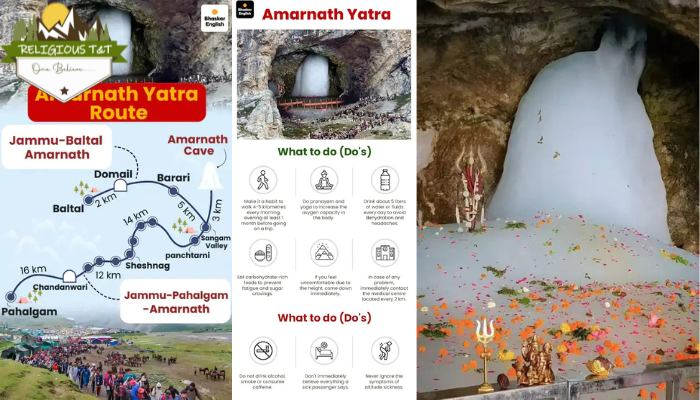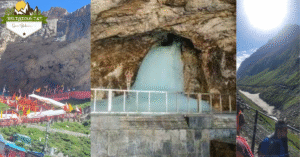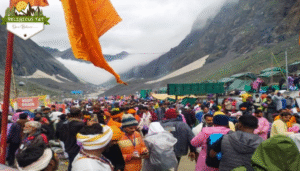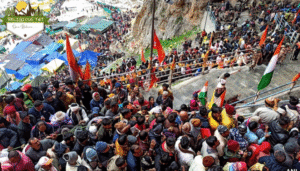The sacred Amarnath Yatra 2025 has once again captured the devotion of thousands, with over 2 lakh pilgrims undertaking the spiritual journey within just 11 days of the Yatra’s commencement. On Sunday alone, around 20,000 pilgrims participated. The yatra, which began on July 3, is progressing via both the Pahalgam and Baltal routes. This massive turnout highlights the deep religious significance and unshakable faith that devotees from across India and abroad hold for Lord Shiva’s Amarnath Cave Shrine, located at an altitude of 3,880 meters in the Himalayas.
Unwavering Faith Amidst Challenging Terrain
The Amarnath Yatra is not just a pilgrimage—it is a test of endurance and devotion. Whether taking the traditional Pahalgam route or the shorter Baltal route, pilgrims brave steep climbs, unpredictable weather, and high altitudes to reach the sacred Ice Lingam, believed to be a natural manifestation of Lord Shiva. Despite these challenges, the enthusiasm of the pilgrims has only intensified this year, making it one of the most remarkable turnouts in recent times.
So far, more than 4 lakh pilgrims have registered for the 38-day yatra, which will conclude on August 9, coinciding with Raksha Bandhan. Last year, the yatra spanned 52 days and saw a turnout of around 5 lakh devotees.
What’s on the Amarnath Yatra route?
- To ensure the safety and comfort of pilgrims undertaking the Amarnath Yatra 2025, a massive deployment of 581 security units has been made. These include personnel from major forces such as the CRPF, BSF, SSB, ITBP, and CISF, creating a multi-layered security shield throughout the pilgrimage route.
- Along the Baltal to Amarnath cave trail, medical camps have been strategically established every 2 kilometers, ensuring timely medical aid to any pilgrim in need. In addition, storage warehouses have been set up at key locations to manage supplies and logistics efficiently.
- This year, four new resting shelters (stands) have been constructed to give yatris a much-needed break during the strenuous journey. Separate paths have also been marked for those walking on foot, riding horses, or traveling via palanquins (palkis) to maintain order and safety along the route.
- A soldier is stationed every 50 meters, offering a sense of constant protection and reassurance for the pilgrims.
Choosing the Right Route: Baltal vs. Pahalgam for Amarnath Yatra 2025
Pilgrims embarking on the Amarnath Yatra 2025 can choose between two main routes—Baltal and Pahalgam—each offering a distinct experience. The Baltal route is generally favored by those seeking a faster and more direct religious journey, while the Pahalgam route appeals to those who wish to immerse themselves in Kashmir’s natural beauty along the way.
However, the Pahalgam route is longer and more physically demanding. The 48-kilometer stretch from the cave to Chandanwari is known for its rocky, dusty trails, and narrow mountain paths. Certain sections do not have protective railings, making the trek more challenging, though some parts do offer dedicated lanes for horses and ponies.
On the second day of the Yatra, ground reports revealed a strong presence of security personnel, including soldiers with dog squads positioned just beyond the cave. The path through Panchtarni, Ganesh Top, and Pissu Top—located at an altitude of 14,800 feet—was dotted with security forces even in remote bugyals (alpine meadows).
This year, the security arrangements appear significantly heightened, ensuring greater protection for the thousands of devotees walking these sacred trails.
Amarnath Yatra 2025: Comparing the Pahalgam and Baltal Routes
Pilgrims heading to the sacred Amarnath Cave Shrine can choose between two main routes—Pahalgam and Baltal. Each offers a unique experience, depending on the pilgrim’s preference, physical ability, and time availability.
1. Pahalgam Route – A Gradual Spiritual Ascent
The Pahalgam route is ideal for those who prefer a longer, more scenic pilgrimage with a gradual climb. Though it takes about three days to reach the holy cave via this route, the initial path is relatively gentle, without steep ascents.
Day 1: The journey begins from Pahalgam base camp, with the first stop at Chandanwari, located 16 km away.
Day 2: A moderate 3 km climb brings pilgrims to Pissu Top, followed by a 9 km trek to Sheshnag, where pilgrims typically halt for the night.
Day 3: The route continues 14 km from Sheshnag to Panchtarni. From there, the final 6 km trek leads to the Amarnath Cave.
This route offers lush green valleys, flowing streams, and picturesque Himalayan views, making the spiritual journey a memorable experience. However, it requires more time and stamina.
2. Baltal Route – The Fast but Tough Option
For those short on time, the Baltal route provides a quicker alternative, requiring just one day to reach the cave. However, it comes with its own set of challenges.
The 14 km trek from Baltal to the Amarnath Cave is steep and physically demanding.
The path is narrow with sharp and risky bends, making it particularly challenging for senior citizens or those with health issues.
While the Baltal route is favored by experienced trekkers and pilgrims aiming for a quick darshan, it demands a high level of physical fitness and caution along the way.
Essential Documents and Preparations for Amarnath Yatra 2025
Before embarking on the Amarnath Yatra 2025, it’s crucial to ensure you are well-prepared both medically and logistically. Here’s a checklist of what you need to carry and how to prepare
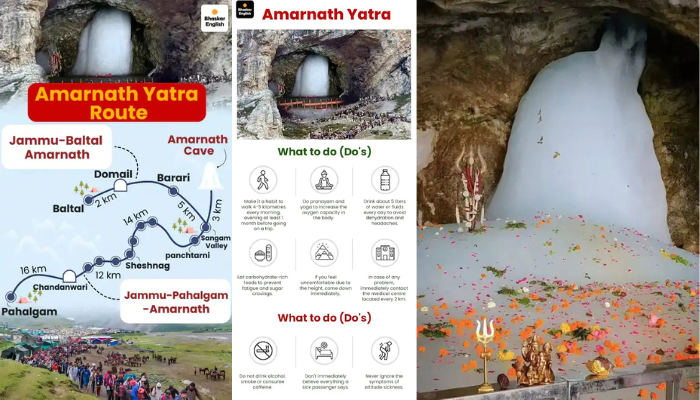
Documents to Carry:
Medical Certificate (Compulsory for all pilgrims)
Four Passport-Size Photographs
Aadhar Card or any valid government ID
RFID Card (issued during registration)
Yatra Application Form (duly filled and signed)
These documents are mandatory for registration and at various checkpoints during the Yatra.
Physical Preparation:
To build the stamina required for the high-altitude trek:
Practice walking 4–5 km daily for at least a month before your journey.
Include breathing exercises like Pranayama in your routine to improve oxygen intake and adapt better to altitude changes.
Essential Items to Carry:
Woollen Clothes (thermal wear, gloves, woollen socks, cap, and shawl)
Raincoat/Poncho (Weather can change suddenly)
Trekking Stick (Helps with balance on rough terrain)
Reusable Water Bottle (Stay hydrated)
Personal Medicine Kit (Include prescribed medications, painkillers, antiseptics, and altitude sickness tablets)
Backpack (Compact but spacious enough for essentials)

